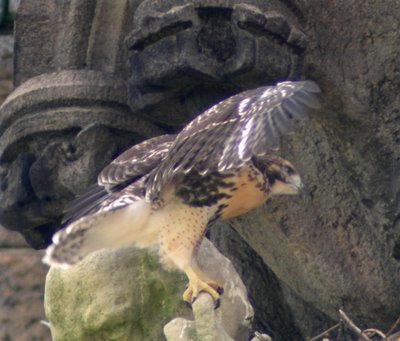
Youngest before.

Youngest now.

Eldest before.

Eldest now.
Marie Winn, author of the marvelous book , REDTAILS IN LOVE, and the equally marvelous website and blog www.mariewinn.com , left a comment referring to the photos posted 2 Jul 06.
Donna,
Today's photos make it seem like the fledglings are losing some of the orange color on their chests. Have you noticed this?
Marie
Hi Marie,
Yes, I absolutely have noticed it.
It does depend some on the light. The more I look at hawks the more I see their feathers are a wonder. I don't know if you've noticed it but when these fledglings are up trees and bathed in the green light of leaves, their feathers incorporate that light and take on a yellowish or downright greenish tinge all over. Their eyes even become green. I'm assuming a feather adaptation that makes them more difficult to see. Which is nifty for them and not so nifty for us.
Another example is that the light late in the day makes the adults and the young both, more reddish all over.
But yes, those orangey chests are taking their leave without a doubt. In most lights now the fledge's breasts are buffy, creamy, or the palest yellow, with just the last vestiges of orangey-ness.
As you've pointed out, the hawks are very visual. Some of us were talking the other day and discussing whether the various color transitions in feather might be cues to the parents that it's time for the "next stage" in youngster care and education.
The obvious just struck me. The babies are growing up and before long they'll be harder and harder to find until we'll only see them by chance on our way to somewhere else.
Oh dear," Empty Nest Syndrome" over actual birds instead of children.
Donna
1 comment:
Interesting observations re color adaptation, Donna -- and the loss of the orange color on their breasts. I liked how you tied in the photos with your thoughts [and Marie Winn's] regarding the subject.
Post a Comment